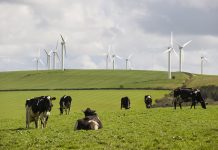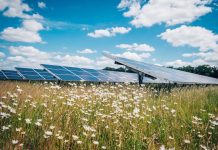
Back in 2016, New Power carried this headline: “Ofgem tells National Grid: ‘We are not “Going Green”’.” That regulatory smackdown of National Grid’s annual Future Energy Scenarios (FES) work – Ofgem was talking about the 2015 “Gone Green” FES scenario and its use in network planning – is now relevant only to writers of punctuation guides.
We have gone green. In the latest FES, launched by National Grid ESO at the end of July, “Steady Progression” is the least green option on the table, and is the only one which breaks the law by failing to hit net zero by 2050. With apologies to National Grid (who don’t generally appreciate people putting words into their mouths), Steady Progression reads like a memo to Government headed “here’s what failure looks like”. And yet, plodding, dismal Steady Progression is greener than 2015’s Gone Green. In Gone Green, renewable power beats “conventional power stations” by 2025/26. In this year’s Steady Progression, that happens by 2022. That’s no criticism of the FES 2015 team: no-one foresaw the speed of transformation that occurred. Given how our understanding of climate change is developing, it’s possible that FES 2020 will also seem unambitious when we look back in five years. Today, however, it’s as bold as brass.
Like its partner project Network Options Assessment (NOA), which looks in more detail at shorter timescales, FES is a major piece of work involving lots of people and much number-crunching. So it’s significant that this year’s FES doesn’t just say “more wind, more solar, more lithium”. Those are proven technologies, each descending its cost curve apace; such statements would have been easy to make. Instead, FES 2020 pins our energy future on three more challenging concepts. In increasing order of significance, these are: bioenergy with carbon capture and storage (BECCS), vehicle-to-grid (V2G), and hydrogen.
I wonder how much V2G will make it into people’s homes, where most electric vehicle charging will occur, and how much of V2G’s contribution to flexible energy use could be substituted by common-or-garden smart charging. But I haven’t run the numbers. In particular, I haven’t examined the role of V2G in managing the last mile of electricity distribution, which in most scenarios must also carry quite a lot of heat. That’s where I yield to the expertise of FES and NOA. In the end, V2G is a question posed to industry: will car manufacturers provide inverters onboard, or must each home fit a DC chargepoint? Either way, it’s a pivot. Chargepoints are going on garage walls now, and while many of them are smart, pretty much none of them are V2G.
Still more striking is the contrast between what appear to be the two core scenarios: “Consumer Transformation” and “System Transformation”. These, again, read like a memo to Government, setting out the main policy choice that needs to be made. In essence, Consumer Transformation relies on a radical change in the way people use and view energy. Clearly, consumers must have a major stake in it for this to work, and energy inequality must be addressed head-on. System Transformation is what we will get if the industry does all the heavy lifting, that is, if talking to consumers is too scary. But we’ll still have to visit nearly every home and make sure the combi boiler and the cooker can burn neat hydrogen. This year’s FES is written to test the mettle of policymakers.
Finally, there’s a goad. Think you’re hard enough? Try “Leading The Way”, where the UK tears into the new energy future and claims its place as world leader in the decarbonisation marketplace. Norway, Iceland, pshaw. Exceptionalism is a guilty pleasure for most politicians, but here it connects to a strong economic argument around the post-lockdown Build Back Better concept: leadership in implementation means leadership in technology.
There is one consistent theme throughout all of this. With most energy being renewable, and excess generation capacity a necessary consequence of that, flexibility is a core component of energy system management – and it’s where a lot of the value will be found. It’s not just about peaks, triads and trips; it’s about managing supply and demand every day, hour and minute. This is true of all future energy scenarios because it’s already happened. At Flexitricity, we’ve pushed the industrial and commercial demand response envelope further than anyone; we’ve created the conditions for smart EV charging to flourish; and we can’t wait to get our teeth into hydrogen electrolysis.
This is also an economic point. However future energy comes out, it has to be paid for. The best way to do that is to ensure a flourishing marketplace gives all consumers a stake in the outcome, and makes flexible, efficient use of energy resources the natural and normal thing to do.
First published on Flexitricity’s site.




re V2G:
there are already cars available with this technology, the inverter on board.
re. going green: here the Wärtsilä Energy Transition Lab to check what is actually ongoing:
https://www.wartsila.com/energy/transition-lab
UK load down by -8% and RE production up by + 20% this year so far.
Forecasting future developments in a new energy world is difficult.
As researchers of the markets are now saying: the market will never go back to previous forecasts:
https://www.dnvgl.com/energy-transition/impact-of-covid19-on-the-energy-transition.html?utm_campaign=GR_GLOB_20Q3_PROM_ETO_2020_Covid-19_Impact&utm_medium
We need only 1 Covid crisis per year (half year lockdown) to meet the climate targets. And we have the second wave now in full swing, something which Alvik and Irvine ( DNVGL) could not included in June 2020.
The climate crisis could develop one Corona-like disaster after the other, the tipping points are now reached.
These disasters have each the potential to reduce the energy demand by another 8% making any investment into new power plants with overhead costs a no-go zone.
Only the power plants with zero overhead costs (no staff, no fuel,no borrowed money/interest rates) can compete.
As the director of Vattenfall/Germany has said already: even wind power is now to expensive,only PV can compete in the future markets.
Hydrogen is far to expensive to have any economical impact on the energy market, a niche product for a micro market.
The energy transition once completed should have a 7-fold overcapacity of max. power demand so at any time the load is guaranteed 100% renewable. Storage like hydrogen have to make a living outside the grid power market once the energy transition is achieved.
US atom power managers see this as well, only broadly subsidised hydrogen technology can guarantee a market for old atom power plants. No one speaks of new reactors any more:
https://www.spglobal.com/platts/en/market-insights/latest-news/electric-power/081120-us-nuclear-fleet-must-adapt-by-operating-flexibly-making-hydrogen-officials
The energy transition doesn’t stop until finished.
After Sizewell B is being switched-off for the entire Summer Torness 1 has now followed. Torness1 reduced it’s output by 1/3 to stabilise the grid and EdF gives no return date:
https://www.edfenergy.com/energy/power-station/daily-statuses
One wonders why EdF hasn’t bought any hydrolysers in time?